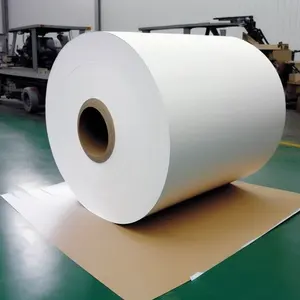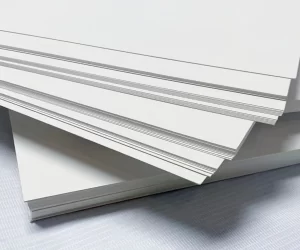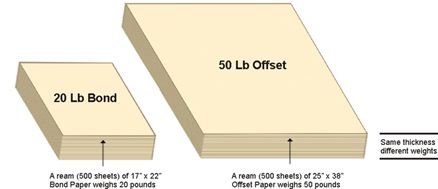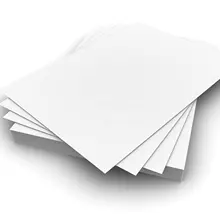The influence of paper weight on 50 gsm offset paper
Understanding Paper Weight and Thickness
In the printing industry, paper weight and thickness play a crucial role in determining the quality and appearance of printed materials. It is important to understand the concepts of basis weight, paper thickness measurement, and their significance in order to make informed decisions when selecting the right paper type for a print project.
What does basis weight mean in paper?
Basis weight is a measure of paper weight and is typically expressed in pounds per ream. It refers to the weight of a ream, which is usually 500 sheets of paper, at its basis size. Different paper types have varying basis weights. For example, copier paper typically has a basis size of 17 x 22 inches, and 500 sheets of 20-pound bond paper at this size will weigh 20 pounds. On the other hand, offset paper has a larger basis size of 25 x 38 inches, and 500 sheets of 50-pound offset paper at this size will weigh 50 pounds.
How is paper thickness commonly measured?
Paper thickness is commonly measured in mils or microns. Mils refer to thousandths of an inch, while microns refer to millionths of a meter. Another term used to describe paper thickness is caliper, which refers to the thickness of paper in thousandths of an inch. The higher the mils or microns, or the greater the caliper, the thicker the paper.
What is the significance of paper weight in the printing industry?
Paper weight plays a significant role in the printing industry as it affects the quality and durability of printed materials. Different weight classes of paper are used for different purposes. The two main weight classes of paper used in printing are text weight and cover weight.
Differentiate between text weight and cover weight paper.
Text weight paper is lighter than cover weight paper. It is commonly used for flyers, letterhead, envelopes, brochures, and magazines. Text weight paper comes in various thicknesses, such as 20#, 24#, 28#, and 32#. These numbers represent the weight of 500 sheets of paper at its basis size. For example, 20# paper weighs 20 pounds for 500 sheets.
On the other hand, cover weight paper is heavy paper used for items like business cards, invitations, and posters. It ranges in weights from 10pt to heavier options like 14pt. The term “point” (pt) refers to the thickness of the paper, where 1 point equals 0.001 inches. For example, 10pt cover stock is 0.010 of an inch thick.
How does understanding paper properties help in choosing the right paper type?
Understanding paper properties, such as weight and thickness, helps in choosing the right paper type for specific printing projects. Different paper types have different characteristics that make them suitable for different purposes. For example, text weight paper is suitable for lightweight applications like flyers, while cover weight paper is recommended for items that require a sturdier material like business cards.
Explain the relationship between paper weight, thickness, and density.
The relationship between paper weight, thickness, and density is interrelated. As the paper weight increases, the paper becomes thicker and denser. A higher paper weight indicates a sturdier paper, which is generally preferred for projects that require durability and a more substantial feel.
How does paper weight affect print project appearance?
Paper weight affects the appearance of a print project in several ways. Heavier paper, such as cover weight paper, tends to feel more luxurious and high-quality. It also provides better stiffness, which is important for projects like business cards or invitations that require a rigid material. Additionally, paper weight affects the way ink is absorbed into the paper. Lighter weight paper may allow the ink to spread more, resulting in less sharp and vibrant print quality.
Understanding the concepts of paper weight and thickness is essential for choosing the right paper type for your print projects. By considering factors such as the intended use, desired appearance, and printer capabilities, you can select the appropriate paper that will enhance the overall quality and impact of your printed materials.
Types and Uses of Paper Stocks
When it comes to printing, choosing the right paper stock is crucial for achieving the desired results. Different types of paper stocks have varying characteristics that make them suitable for specific printing projects. In this section, we will explore the common types of paper stocks used in printing, the difference between coated and uncoated paper stocks, and their respective uses and applications. We will also discuss when it is recommended to use cover weight paper for printing and how coating and finish affect the appearance of printed materials. Additionally, we will highlight the benefits of using uncoated paper for specific applications.
Common Types of Paper Stocks Used in Printing
There is a wide variety of paper stocks available for printing, each with its own unique characteristics. The following are some of the most commonly used types of paper stocks:
- Bond Paper: Bond paper is a lightweight, uncoated paper that is commonly used for everyday printing needs such as photocopies, letters, and forms. It is known for its durability and crisp texture. Bond paper is available in various weights, with 20 lb and 24 lb being the most common.
- Writing Paper: Writing paper, also known as stationery paper, is a medium-weight uncoated paper that is commonly used for letterheads, resumes, and other professional documents. It offers a smooth surface that is suitable for writing with a pen or a pencil.
- Ledger Paper: Ledger paper is a heavyweight uncoated paper that is commonly used for keeping records, accounting, and bookkeeping. It is known for its resistance to tearing and its ability to withstand frequent handling.
- Offset Paper: Offset paper is a versatile uncoated paper that is commonly used for a wide range of printing projects, including brochures, catalogs, and books. It is available in a variety of weights, with 50 lb being a popular choice. Offset paper is known for its high ink absorption and excellent print quality.
- Bristol Paper: Bristol paper is a heavyweight uncoated paper that is commonly used for art and illustration projects, as well as for technical drawings and blueprints. It has a smooth surface and is available in various weights.
- Index Paper: Index paper is a heavyweight uncoated paper that is commonly used for index cards, dividers, and file folders. It is known for its stiffness and durability, making it ideal for organizing and filing purposes.
Coated vs. Uncoated Paper Stocks
Coated and uncoated paper stocks differ in terms of their surface finish and ink absorption properties. Coated paper has a layer of coating applied to its surface, which can be glossy or matte. This coating enhances the paper’s smoothness, brightness, and color vibrancy. Coated paper is commonly used for high-end printed materials such as magazines, brochures, and postcards.
On the other hand, uncoated paper does not have a coating applied to its surface. It has a more natural and textured feel, which can give printed materials a more rustic or organic look. Uncoated paper is commonly used for letterheads, envelopes, and other business documents as it is easier to write on and absorbs ink well.
Uses of Different Paper Stocks
Each type of paper stock serves a specific purpose and is suitable for different printing projects. Here are some common uses of the paper stocks mentioned earlier:
- Bond Paper: Suitable for everyday printing needs such as photocopies, letters, and forms.
- Writing Paper: Ideal for professional documents such as letterheads and resumes.
- Ledger Paper: Used for keeping records, accounting, and bookkeeping purposes.
- Offset Paper: Recommended for a wide range of printing projects, including brochures, catalogs, and books.
- Bristol Paper: Used for art and illustration projects, as well as technical drawings and blueprints.
- Index Paper: Ideal for index cards, dividers, and file folders.
When to Use Cover Weight Paper
Cover weight paper, as the name suggests, is a heavyweight paper that is commonly used for items that require durability and stiffness, such as business cards, invitations, and postcards. Cover weight paper is available in various thicknesses, ranging from 10pt to heavier options like 14pt.
When selecting cover weight paper, it is important to consider the specific printing project and the desired end result. Thicker cover weight paper may require scoring if it needs to be folded, in order to achieve a cleaner and more professional fold.
Impact of Coating and Finish on Printed Materials
The coating and finish of a paper stock can significantly impact the appearance of printed materials. Coated paper stocks, with their glossy or matte finish, tend to have brighter colors and sharper images. The coating helps to seal the ink on the surface of the paper, resulting in vibrant and crisp prints.
On the other hand, uncoated paper stocks offer a more natural and textured look. They have a softer appearance and can provide a more organic feel to printed materials. Uncoated paper stocks are often chosen for projects that require a more tactile and rustic aesthetic.
Benefits of Using Uncoated Paper for Specific Applications
Using tables can be an effective way to visualize data from the blog post. Here are two tables that provide additional information related to the topic:
Table 1: Comparison of Basis Weight for Different Paper Types
| Paper Type | Basis Weight (lbs) |
|---|---|
| Copier Paper | 20 |
| Offset Paper | 50 |
| Bond Paper | Varies (e.g., 24 lb) |
| Cover Weight Paper | Varies (e.g., 14 pt) |
| Writing Paper | Varies (e.g., 20 lb) |
| Ledger Paper | Varies (e.g., 50 lb) |
| Bristol Paper | Varies (e.g., 28 lb) |
| Index Paper | Varies (e.g., 110 lb) |
Table 2: Comparison of Paper Thickness in Mils and Microns
| Paper Type | Thickness (mils) | Thickness (microns) |
|---|---|---|
| Copier Paper | 4 – 5 | 100 – 125 |
| Offset Paper | 4 – 6 | 100 – 150 |
| Bond Paper | Varies (e.g., 4 – 7) | Varies (e.g., 100 – 175) |
| Cover Weight Paper | Varies (e.g., 10 – 20) | Varies (e.g., 250 – 500) |
| Writing Paper | 4 – 6 | 100 – 150 |
| Ledger Paper | 6 – 10 | 150 – 250 |
| Bristol Paper | Varies (e.g., 8 – 20) | Varies (e.g., 200 – 500) |
| Index Paper | 6 – 12 | 150 – 300 |
These tables provide a concise summary of the paper weight and thickness for different types of paper mentioned in the blog post. They serve as visual aids to help readers understand the differences between various paper types and their respective characteristics.
FAQs about 50 Offset Paper Details:
What makes offset paper stand out from other types?
In offset paper, what is the basis weight of 50 offset paper?
How versatile is 50 offset paper in printing needs?
What are the benefits of using 50 offset paper?
What are the ideal uses and applications of 50 offset paper?
In conclusion, understanding paper weight and thickness is crucial for printing projects. Different paper stocks have specific uses, such as coated and uncoated options. Learning about 50 offset paper’s benefits can improve print project outcomes, especially for text-heavy designs. Knowledge of these paper properties aids in selecting the right type for your needs. Make informed decisions for better print results.





